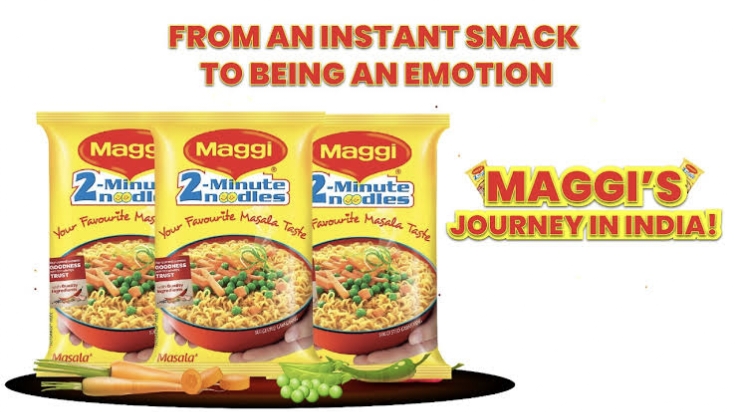My Blog
How Maggi Became a Household Name in India

Maggi is one of the most iconic brands in Indian business history. It has been an integral part of our childhood. But from a business standpoint, the most fascinating thing about Maggi is that back in 1983, both Maggi and instant noodles were completely alien to the majority of Indians.
Nestlé single-handedly created a ₹937 crore market and has been a market leader in the domain for 38 years. Despite giant rivals like ITC, Marico, and Unilever, Maggi holds a whopping 60% market share in the instant noodle segment.
The Question: How Did Nestlé Create a Market for a Seemingly Alien Dish in India?
This story dates back to 1950s Japan. During that time, the country was still recovering from World War II, and noodles were one of the most affordable foods in the market. It was during this period that a Japanese man named Momofuku Ando created a type of noodles that could be prepared quickly and cheaply, making the revolutionary product that we know today as instant ramen noodles.
These noodles became a game changer during the economic boom in Japan. They became such a big hit that, though they cost six times more than normal noodles, they were bought in extremely large quantities. The product soon started traveling abroad to the US and other countries. Even today, the parent company of Ramen, Nissin, accounts for 50% of the billion-dollar instant noodle market in Japan.
While this was happening, Nestlé was carefully observing the markets, realizing how big a goldmine instant noodles were in Japan. But they cleverly chose not to pursue the Japanese market. There was a clear market, a scalable product, and a booming economy. So why did Nestlé not enter Japan?
There are two reasons for that:
- Japan was not so liberal, making it very difficult to operate as a foreign company.
- Why go to war against a monopoly when you can create your own?
Nestlé started exploring every other country to create a market for instant noodles. One of the biggest markets of all was obviously India. So, Nestlé entered the Indian market in 1983.
Introducing Maggi to India
As mentioned earlier, both the concept of instant noodles and the Maggi brand were completely alien to us. We were still a closed country with hardly any foreign companies in the market, and Western influence was relatively very less.
Then the question arises: How did Nestlé turn Maggi into such an integral part of our lives?
Well, that is because Nestlé clearly understood both its customer and consumer. If you look at instant noodles as a product, anyone and everyone can consume it, from a school kid to a 40-year-old man. Noodles are one of the most generic dishes in the market. But Nestlé understood the fundamental marketing principle that if you try to sell to everyone, you will end up selling to no one.
So their marketing team started finding the best niche profiles to find their ideal target audience. That is when they carefully picked two categories: mothers and children. This begs the question: Why?
For the adoption of any alien product, it has to meaningfully cater to the pain of the audience and the interest of the audience. In the case of Nestlé, there are two primary stakeholders: the consumer and the customer. The consumer is the child who eats the Maggi, and the customer is the mother who purchases it.
Addressing the Pain Points
During 1983, the pain point for mothers was offering their children a less tedious, but tasty and filling snack after school. A hectic day wouldn’t allow both working parents and homemakers to cook more than three whole meals a day.
This is where Maggi became an opportunist and positioned itself as the perfect solution for mothers – a super easy and tasty meal alternative for their children. This is how the tagline “2 Minute Mein Maggi” was born. We’ve all seen the commercial; it showcases a mother preparing Maggi for the kids only to see them delighted by its taste.
Engaging with Children
Apart from this tactic, Nestlé also reached out to school kids, sponsored quizzes and events, and even gave them free hampers of Maggi products. This was followed by widespread sampling, with over 4 million new contacts every year. Nestlé also began advertising on TV channels during peak time, when children were watching Power Rangers, Dragon Ball Z, and Ninja Hathori.
This is how, by positioning itself accurately and catering to the pain and interest of both its consumers and customers, Maggi established itself as an integral part of our lives.
Why Competitors Couldn’t Replicate Maggi’s Success
Despite Maggi’s success, why couldn’t other brands like ITC, Unilever, and Nissin achieve the same?
- Evolved Supply Chain: Nestlé evolved its supply chain for 25 long years, which is almost impossible to replicate. It controlled the supply chain end to end. Nissin, the parent company of Ramen, tried to enter the market but struggled to find national distribution. Its alliances with both Hindustan Unilever and Marico failed.
- Market Penetration: Nestlé has achieved an unmatched level of penetration even in Tier 3 and Tier 4 cities of India. More people there are familiar with the term Maggi than even instant noodles. In technical terms, based on socio-economic status, the Indian audience could be categorized into seven classes ranging from A1 to E2. The top segment consisted of SEC classes A1, A2, and B1, the middle segment was B2 and C, and the bottom segment was D, E1, and E2. The top and middle segment was already captured by 2005 through their conventional efforts, but they saw that the real opportunity was in SEC classes C and D that represented over 40% of the market.
After extensive study, the first product to be launched was Chotu (or small) Maggi, priced at just ₹5, aimed at penetrating the lower segment of the market. The communication was done in local vernacular languages, and the distribution system was intricately designed with strategic wholesalers and redistributors to reach 2.2 million outlets across the country. As a result, the household penetration numbers shot up from 45% to 71% for the C class and from 31% to 62% for SEC Classes D/E in four short years from 2006 to 2010.
This is the reason why, when ITC and Unilever entered the market, they found it very difficult to achieve this level of penetration and brand recall value.
- Customer Connection: There is an impeccable connection that Maggi has established with its customers. A classic demonstration of this was seen in 2015 when the Maggi ban took place. As soon as the ban was enforced, Maggi disappeared from the stores for five long months, and their market share went from 75% to 0% within no time. But as soon as Maggi came back, they had a “We Miss You Too” campaign, where the brand asked fans to share stories about how much they missed Maggi on social media.
This was not some Michael Jordan X Nike product or the iPhone; it was just an instant noodle brand expecting fans to share their memories. But as we all know, it turned out to be one of the most successful campaigns Nestlé had ever executed. Fans from all across the country started pouring in their love for Maggi. Snapdeal sold out a whopping 60,000 Maggi Welcome Kits within five minutes of the Maggi Flash Sale, and hashtags such as #DILKIDEALWITHMAGGI started trending on Twitter after the sale resumed.
This was the extraordinary level of connection that Maggi had established with its audience. It’s no surprise that Unilever and Nissin failed with a player like Maggi in the market.
Conclusion: Lessons from Maggi’s Marketing Strategy
- Choose the Right Market: While most brands spend time and resources on how to penetrate a market, only a few brands spend time and money to find which market to penetrate. Some of the most revolutionary products in the market are often products that created a market for themselves. Apple never tried to compete with Rolex to make mechanical watches; they instead created a market for smartwatches and now they are ahead of Rolex. Henry Ford had the option to compete with luxury cars, but he instead created a market at the bottom of the pyramid. In our case, Maggi created a market for instant noodles in India instead of competing with Nissin in Japan.
- Target Specific Audiences: If you try to sell to everybody, you will end up selling to nobody. Always find a specific target audience for your product, no matter how generic. Nestlé targeted mothers and children specifically, which led to their massive success.
- Understand Pain and Interest: Identify the pain points and interests of your audience. Your accuracy in spotting this is directly proportional to the ease of adoption of your product. Nestlé understood the pain of mothers being too tired to make an evening meal and captured children’s interest through cartoon channels and school competitions.
- Sell Emotions, Not Just Products: While good brands sell you a product, great brands sell you an emotion. Maggi is a testament to this principle.
“People might forget what you said but they will never forget how you made them feel!”

November 18, 2025
Glad I observed this on google .
November 21, 2025
I simply wanted to write down a small note in order to express gratitude to you for all of the marvelous tips and hints you are posting at this website. My extended internet investigation has finally been rewarded with awesome suggestions to go over with my company. I ‘d suppose that most of us website visitors are undoubtedly endowed to live in a magnificent place with very many special people with very beneficial things. I feel somewhat blessed to have encountered your entire site and look forward to many more brilliant moments reading here. Thank you again for a lot of things.